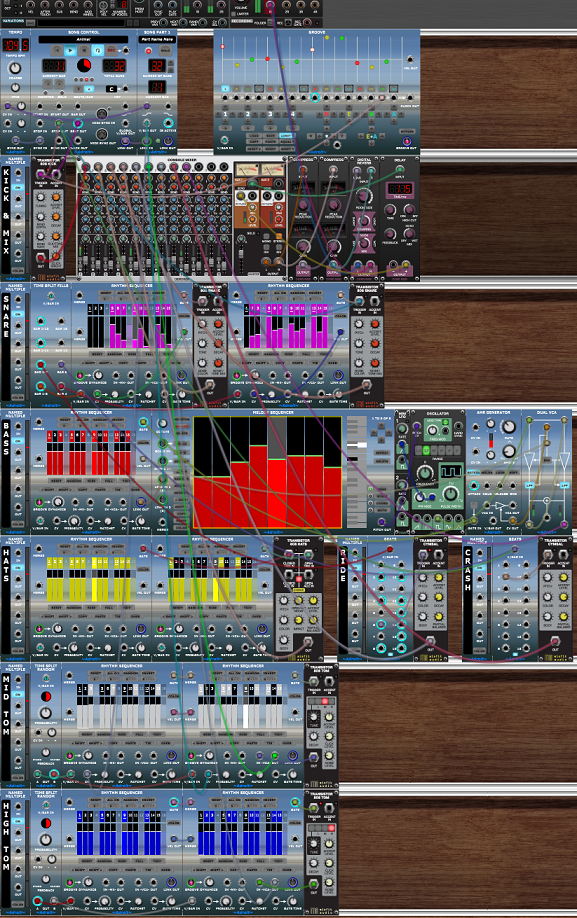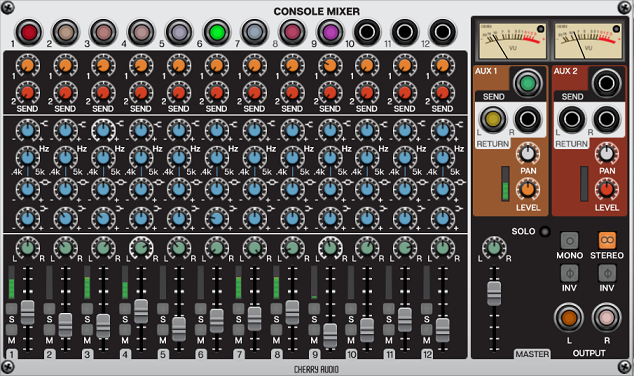Click on the button below to download the .voltagepreset file then open it to launch Voltage Modular with the patch ready built.

As with all the other demonstration presets on this website this is a slightly contrived patch. The intention is to demonstrate a number of useful techniques rather than showcase a polished production.
The name Animal is a homage to the drummer of Dr. Teeth and the Electric Mayhem. So don’t expect too much subtlety here.
This patch demonstrates how you might begin to program a fairly basic, vaguely acoustic sounding, “four-piece”. In drum kit terminology that means a bass drum, snare and two toms. Other kit like cymbals are of course also included but don’t get counted in the four. So generally a four-piece also includes a high-hat, ride cymbal and a crash cymbal. Ask any roadie and they’ll say this should be called a seven-piece.
Anyway, a four (slash seven) piece drum kit is about as primitive as you get in modern times so it’s something worth exploring even if you have absolutely no interest in conventional music genres. It represents the sort of minimum level of rhythmical orchestration that LSSP should be able to easily handle.
Overview
This patch is seven cabinets high but is not particularly complicated. Named Multiple modules are used to label what each part of the patch does.
In the top cabinet we have a Tempo, Song Control and Song Part module working in concert as a Song Control Sequencer.
The Tempo module receives a tiny amount of CV control that makes the tempo speed up very slightly as the song progresses.
The V/BAR OUT from the Song Part module drives quite a few things so Voltage Modular’s bus connection facility is used to reduce cable clutter.
On the right-hand side of the top cabinet we have a Groove module. Its output in fed to all nine of the Rhythm Sequencers in this patch. Again Voltage Modular’s bus connection facility is used to reduce cable clutter.
The second cabinet contains the Kick Drum module along with the Console Mixer, Compressors, Reverb and Delay modules.
The third cabinets handles the snare drum.
The fourth cabinet produces an ostinato bass. This bass line is initially useful for making the bar boundaries obvious but it also interferes with listening to the details of the drums so you can remove it by clicking on the Mute button of channel 9 on the Console Mixer.
The fifth cabinet handles the hats, ride and crash cymbals.
The sixth cabinet handles the mid tom.
Finally the seventh cabinet handles the high tom.
The mix
The Console Mixer module channels are assigned as follows…
- Kick
- Main snare
- Snare fill
- Hats
- Ride
- Mid tom
- High tom
- Crash
- Bass

The Send/Return 1 channel is used to feed a Delay module that adds a little echo to the snare fill and bass. One wouldn’t normally apply echo to bass but as the bass is a crude one oscillator sub-patch the touch of echo adds a little interest. Another unusual thing is treating the main snare and snare fill as separate instruments. This makes the snare sound less authentic but more interesting. If you want an authentic sound then pay attention to stereo positioning so that it matches the physical layout of a real kit and when programming patterns remember that you can’t have open and closed hats at the same time and that drummers generally only have two hands and two feet.
Only minimal EQ is applied to try to stop the bass region being swamped by too many competing signals.
The mixer’s main outputs are fed to a pair of Compress modules before being sent to the Digital Reverb module and the main outputs. Compression is a technique used (some would say misused) to obtain a subjective feeling of loudness. A compressor works by monitoring the strength of the input and automatically reducing the gain when the input peaks. This obviously reduces the loudness but this is compensated for by adding extra gain. The end result is a signal where the quiet bits are turned up. This reduction in dynamic range means that while the peak volume remains the same, the average volume increases. You can hear the subtle effect by bypassing the Compress modules.
Compression is particularly useful on drums as it makes them sound more lively while at the same time making them sit more evenly in the mix. The Compress module is very basic compared with a professional studio compressor but still does a reasonable job.